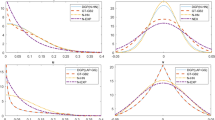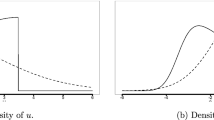Abstract
Using statistically designed experiments, 12,500 observations are generated from a “4-pieced Cobb-Douglas function” exhibiting increasing and decreasing returns to scale in its different pieces. Performances of DEA and frontier regressions represented by COLS (Corrected Ordinary Least Squares) are compared at sample sizes ofn=50, 100, 150 and 200. Statistical consistency is exhibited, with performances improving as sample sizes increase. Both DEA and COLS generally give good results at all sample sizes. In evaluating efficiency, DEA generally shows superior performance, with BCC models being best (except at “corner points”), followed by the CCR model and then by COLS, with log-linear regressions performing better than their translog counterparts at almost all sample sizes. Because of the need to consider locally varying behavior, only the CCR and translog models are used for returns to scale, with CCR being the better performer. An additional set of 7,500 observations were generated under conditions that made it possible to compare efficiency evaluations in the presence of collinearity and with model misspecification in the form of added and omitted variables. Results were similar to the larger experiment: the BCC model is the best performer. However, COLS exhibited surprisingly good performances — which suggests that COLS may have previously unidentified robustness properties — while the CCR model is the poorest performer when one of the variables used to generate the observations is omitted.
Similar content being viewed by others
References
Banker, R.D., Estimating most productive scale size using Data Envelopment Analysis, European Journal of Operational Research 17, 1984, 35–44.
Banker, R.D., Maximum likelihood, consistency and Data Envelopment Analysis statistical foundation, Management Science 39, 1993, 1265–1273.
Banker, R.D., I. Bardhan and W.W. Cooper, A note on returns to scale in DEA, European Journal of Operational Research, 1995, forthcoming.
Banker, R.D., H. Chang and W.W. Cooper, Equivalences and implementation of alternative methods for determining returns-to-scale in DEA, European Journal of Operational Research, 1996, forthcoming.
Banker, R.D., A. Charnes and W.W. Cooper, Models for the estimation of technical and scale inefficiencies in Data Envelopment Analysis, Management Science 30, 1984, 1078–1092.
Banker, R.D., A. Charnes, W.W. Cooper and A. Maindiratta, A comparison of Data Envelopment Analysis and translog estimates of production frontiers using simulated observations from a known technology, inApplications of Modern Production Theory in Efficiency and Productivity, A. Dogramacci and R. Färe, eds., Kluwer Academic, New York, 1987, pp. 33–55.
Banker, R.D., A. Charnes, W.W. Cooper and A. Schinnar, A bi-extremal principle for frontier estimation and efficiency evaluation, Management Science 27, 1981, 1370–1382.
Banker, R.D. and W.W. Cooper, Validation and generalization of DEA and its results, TOP 2, 1994, 249–297.
Banker, R.D. and A. Maindiratta, Piecewise loglinear estimation of efficient production surfaces, Management Science 32, 1986, 126–135.
Banker, R.D. and R.M. Thrall, Estimation of returns to scale using Data Envelopment Analysis, European Journal of Operational Research 62, 1992, 74–84.
Bardhan, I., W.W. Cooper, G. Kozmetsky and S. Kumbakhar, Simulation studies of DEA and regression combinations for evaluating performance, Research Report, Graduate School of Business and IC2 Institute, The University of Texas at Austin, 1994.
Bowlin, W.F., A. Charnes, W.W. Cooper and H.D. Sherman, Data Envelopment Analysis and regression approaches to efficiency evaluation and estimation, Annals of Operations Research 2, 1985, 113–138.
Chang, K. and Y. Guh, Linear production functions and the Data Envelopment Analysis, European Journal of Operational Research 52, 1991, 215–233.
Charnes, A., W.W. Cooper, A. Lewin and L. Seiford, DEA usages and interpretations,12th International IFORS Congress, Athen, Greece, 1990.
Charnes, A., R.L. Clarke and W.W. Cooper, Testing for organization slack with R. Banker's game theoretic formulation of DEA, Research in Governmental and Nonprofit Accounting 5, 1989, 211–230.
Charnes, A., W.W. Cooper, T. Divine and T.W. Ruefli, Comparisons of DEA and existing ratio and regression systems for effecting efficiency evaluations of regulated electric cooperatives in Texas, Research in Governmental and Nonprofit Accounting 5, 1989, 187–210.
Charnes, A., W.W. Cooper, A. Lewin and L. Seiford (eds.),Data Envelopment Analysis: Theory, Methodology, and Applications, Kluwer Academic, Boston, 1994.
Charnes, A., W.W. Cooper and E. Rhodes, Measuring the efficiency of decision making units, European Journal of Operational Research 2, 1978, 429–444.
Charnes, A., W.W. Cooper, L. Seiford and J. Stutz, Invariant multiplicative efficiency and piecewise Cobb-Douglas envelopments, Operations Research Letters 2, 1983, 101–103.
Cooper, W.W. and A. Gallegos, A combined DEA-stochastic frontier approach to Latin American airline efficiency evaluations, Research Report, Graduate School of Business, The University of Texas at Austin, 1991.
Cooper, W.W., S. Kumbakhar, R.M. Thrall and X. Yu, DEA and stochastic frontier analyses of the 1978 Chinese economic reforms, Socio-Economic Planning Sciences 2, 1995, 85–112.
Cooper, W.W., K. Tone, H. Takamori and T. Sueyoshi, Data Envelopment Analysis: Survey and interpretations, Communications of the Operations Research Society of Japan, August, September and October issues, 1994. In Japanese, English versions are available upon request to the authors.
Färe, R., S. Grosskopf and C.A.K. Lovell,The Measurement of Efficiency of Production, Kluwer-Nijhoff, Boston, 1985.
Førsund, R., C.A.K. Lovell and P. Schmidt, A survey of frontier production functions and of their relationship to efficiency measurements, Journal of Econometrics, 1980, 5–25.
Førsund, F.R. and L. Hjalmarsson, Generalized Farrell measures of efficiency: An application to milk processing in Swedish diary plants, The Economic Journal 89, 1979, 294–315.
Greene, W.H., Maximum likelihood estimation of econometeric frontier functions, Journal of Econometrics, 1980, 27–56.
Gong, B.H. and R.C. Sickles, Finite sample evidence on the performance of stochastic frontiers and Data Envelopment Analysis using panel data, Journal of Econometrics 51, 1992, 259–284.
Kittelsen, S.A.C., Stepwise DEA: Choosing variables for measuring technical efficiency in Norwegian electricity distribution, Memo, Department of Economics, University of Oslo Foundation for Research in Economics and Business Administration, 1993.
Koopmans, T.C., Analysis of production as an efficient combination of activities, inActivity Analysis of Production and Allocation, T.C. Koopmans, ed., Wiley, New York, 1951.
Koopmans, T.C.,Three Essays on the State of Economic Science, McGraw-Hill, New York, 1957.
Kumbakhar, S.C., Estimation of input-specific technical and allocative inefficiency in stochastic frontier models, Oxford Economic Papers 40, 1988, 535–549.
Olson, J.A., P. Schmidt and D.A. Waldman, A Monte Carlo study of estimators of stochastic frontier production functions, Journal of Econometrics, 1980, 67–82.
Richmond, J., Estimating the efficiency of production, International Economic Review, 1974, 515–521.
Srivastava, V.K. and D.E.A. Giles,Seemingly Unrelated Regression Equations Models, Marcel Dekker, New York, 1987.
Thompson, R.G., P.S. Dharmapala and R.M. Thrall, DEA sensitivity analysis of efficiency measures with applications to Kansas farming and Illinois coal mining, inData Envelopment Analysis: Theory, Methodology, and Applications, A. Charnes, W.W. Cooper, A. Lewin and L. Seiford, eds., Kluwer Academic, Boston, 1994.
Walters, A.D. and D.L. Adolphson, An investigation of scale efficiency measures, Working Paper No. 0035, The J. Willard and A.S. Marriott School of Management, Brigham Young University, 1993.
Zhu, J. and Z. Shen, A discussion of testing returns to scale, European Journal of Operational Research 81, 1995, 590–596.
Author information
Authors and Affiliations
Rights and permissions
About this article
Cite this article
Banker, R.D., Chang, H. & Cooper, W.W. Chapter 11 Simulation studies of efficiency, returns to scale and misspecification with nonlinear functions in DEA. Ann Oper Res 66, 231–253 (1996). https://doi.org/10.1007/BF02187300
Issue Date:
DOI: https://doi.org/10.1007/BF02187300




